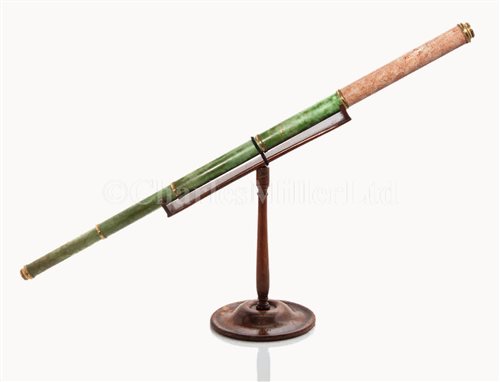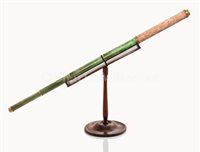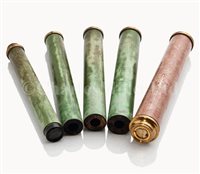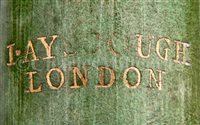3rd Nov, 2015 12:00
Maritime and Scientific Models, Instruments & Art ('Encounter')
191
[M] A VERY FINE ¾IN. PINK SHAGREEN AND GILT-BRASS...
signed on the fourth draw as per title, parallel main tube with ray skin 'jewels' and delicate pink staining, gilt brass section dividers to green vellum-covered card draws with inked focus lines and dust slides each end -- 14½in. (37cm.) closed; 42in. (107cm.) open, mounted on associated turned wooden Georgian telescope table stand -- 18in. (46cm.) high
(2)
This telescope represents an expensive commission made at the apex of the pre-achromatic development of the refracting telescope and dates to between 1747 and the maker's death in 1759 at just 40 years of age. James Ayscough (1719-59) was one of the most creative and innovative London telescope opticians in the formative experimental period which led directly to the achromatic doublet objective being patented in 1758 by John Dollond Snr (1703-61). The son of a Wiltshire parson, at 13 he was apprenticed to James Mann II (w.1706-d.1756) and as such was at the forefront of many such achromatic lens trials from their inception by the London barrister Chester Moor Hall. Latterly educated at Christ's College, Cambridge, Ayscough gained his Freedom in 1740 under James Mann II, with whom he was later in partnership between 1743 and 1747. He became an independent maker in 1748 where he was known for quality experimental optical designs and published a fine optical treatise in 1752 entitled A Short Account of the Eye and Nature of Vision, chiefly designed to Illustrate the Use and Advantage of Spectacles. This aroused great jealousy and ire amongst other London opticians for promoting hard green crown glass, being rather expensive to procure and time-consuming to polish.
Literature: 1. Gee, B, ed. McConnell, A & Mirrison-Low, A: Francis Watkins and the Dollond Patent Telescope Controversy, Ashgate, pp.41-47; 2. Talbot, S: Shagreen and Fish-skin - on Scientific Instruments, their Cases and Étui c.1700-1800, SIS Bulletin No.123 Dec. 2014, pp.10-27; 3. Louman & Zuidervaart: A Certain Instrument for Seeing Far, Wassenaar, 2013, Nos. 49, 152, 180.
Sold for £4,712
Estimated at £2,000 - £3,000
(inc. buyer's premium of 24%)
Condition Report
the telescope in excellent overall condition with fine, clear optics; the stand is universal and telescope secured by a tie, one of the threaded screw thread arbors is loose.
We are pleased to provide you with a general report of the condition of this property. Since we are not professional conservators or restorers, we urge you to consult with a restorer or conservator of your choice who will be better able to provide a detailed, professional report. Prospective buyers should inspect each lot to satisfy themselves as to condition and must understand that any statement made by Charles Miller Ltd is merely a subjective, qualified opinion. Prospective buyers should also refer to any Important Notices regarding this sale, which are printed in the Sale Catalogue. NOTWITHSTANDING THIS REPORT OR ANY DISCUSSIONS CONCERNING A LOT, ALL LOTS ARE OFFERED AND SOLD “AS IS” IN ACCORDANCE WITH THE CONDITIONS OF BUSINESS PRINTED IN THE SALE CATALOGUE.
signed on the fourth draw as per title, parallel main tube with ray skin 'jewels' and delicate pink staining, gilt brass section dividers to green vellum-covered card draws with inked focus lines and dust slides each end -- 14½in. (37cm.) closed; 42in. (107cm.) open, mounted on associated turned wooden Georgian telescope table stand -- 18in. (46cm.) high
(2)
This telescope represents an expensive commission made at the apex of the pre-achromatic development of the refracting telescope and dates to between 1747 and the maker's death in 1759 at just 40 years of age. James Ayscough (1719-59) was one of the most creative and innovative London telescope opticians in the formative experimental period which led directly to the achromatic doublet objective being patented in 1758 by John Dollond Snr (1703-61). The son of a Wiltshire parson, at 13 he was apprenticed to James Mann II (w.1706-d.1756) and as such was at the forefront of many such achromatic lens trials from their inception by the London barrister Chester Moor Hall. Latterly educated at Christ's College, Cambridge, Ayscough gained his Freedom in 1740 under James Mann II, with whom he was later in partnership between 1743 and 1747. He became an independent maker in 1748 where he was known for quality experimental optical designs and published a fine optical treatise in 1752 entitled A Short Account of the Eye and Nature of Vision, chiefly designed to Illustrate the Use and Advantage of Spectacles. This aroused great jealousy and ire amongst other London opticians for promoting hard green crown glass, being rather expensive to procure and time-consuming to polish.
Literature: 1. Gee, B, ed. McConnell, A & Mirrison-Low, A: Francis Watkins and the Dollond Patent Telescope Controversy, Ashgate, pp.41-47; 2. Talbot, S: Shagreen and Fish-skin - on Scientific Instruments, their Cases and Étui c.1700-1800, SIS Bulletin No.123 Dec. 2014, pp.10-27; 3. Louman & Zuidervaart: A Certain Instrument for Seeing Far, Wassenaar, 2013, Nos. 49, 152, 180.
Auction: Maritime and Scientific Models, Instruments & Art ('Encounter'), 3rd Nov, 2015




